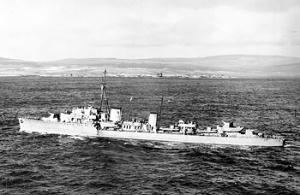Name Isaac Sweers Commissioned 29 May 1941 Launched 16 March 1940 Draft 2.8 m | Laid down 26 November 1938 Construction started 26 November 1938 Length 107 m | |
 | ||
Namesake Admiral Isaac Sweers (1622–1673) Fate Torpedoed and sunk on 13 November 1942 dead 108 survivors 86 Class and type Gerard Callenburgh-class destroyer Builder John I. Thornycroft & Company | ||
Hnlms isaac sweers rc destroyer
HNLMS Isaac Sweers, (Dutch: Hr. Ms. Isaac Sweers) was a Gerard Callenburgh-class destroyer of the Royal Netherlands Navy.
Contents
Design and construction
The keel was laid on 26 November 1938. The ship was launched on 16 March 1940 and the unfinished ship was evacuated to England after the German invasion of the Netherlands. She was completed in Great Britain, with six British 4-inch dual purpose guns instead of planned five 120 mm guns. The ship was modern for her time, she was fast and had two fully stabilised 40 mm Bofors AA-guns, each with its own "Hazemeyer" fire control.
The ship's plans were saved from the Germans and elements were incorporated into Royal Navy ship designs.
Operations
Isaac Sweers was part of the Allied flotilla of destroyers which torpedoed and sank the Italian cruisers Alberico da Barbiano and Alberto da Giussano on 13 December 1941, at the Battle of Cape Bon. She riddled Alberto da Giussano with gunfire at short range and launched four torpedoes against the Italian torpedo boat Cigno; all of them missed their target. She escorted the important convoy MW 8B to Malta in January 1942. During this mission the British destroyer Gurkha was torpedoed by the German submarine U-133 on 12 January 1942. Isaac Sweers towed the stricken British destroyer through a field of burning oil and saved her entire crew of 240 sailors. They were taken to Tobruk.
On 13 November 1942, during Operation Torch, Isaac Sweers was hit by two torpedoes from the German submarine U-431 under command of Wilhelm Dommes. She sank with the loss of 108 of her 194 crew.
